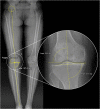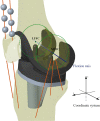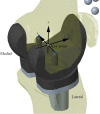Restoration of Joint Inclination in Total Knee Arthroplasty Offers Little Improvement in Joint Kinematics in Neutrally Aligned Extremities
- PMID: 33996784
- PMCID: PMC8116507
- DOI: 10.3389/fbioe.2021.673275
Restoration of Joint Inclination in Total Knee Arthroplasty Offers Little Improvement in Joint Kinematics in Neutrally Aligned Extremities
Abstract
Kinematically aligned total knee replacements have been shown to better restore physiological kinematics than mechanical alignment and also offer good postoperative satisfaction. The purpose of this study is to evaluate the extent to which an inclined joint line in a kinematically aligned knee can alter the postoperative kinematics. A multi-body dynamic simulation was used to identify kinematic changes in the joint. To accurately compare mechanical alignment, kinematic alignment and a natural knee, a "standard" patient with neutral alignment of the lower extremities was selected for modeling from a joint database. The arthroplasty models in this study were implanted with a single conventional cruciate-retaining prosthesis. Each model was subjected to a flexion movement and the anteroposterior translation of the femoral condyles was collected for kinematic analysis. The results showed that the mechanical alignment model underwent typical paradoxical anterior translation of the femoral condyles. Incorporating an inclined joint line in the model did not prevent the paradoxical anterior translation, but a 3° varus joint line in the kinematic alignment model could reduce the peak value of this motion by about 1 mm. Moreover, the inclined joint line did not restore the motion curve back to within the range of the kinematic curve of the natural knee. The results of this study suggest that an inclined joint line, as in the kinematic alignment model, can slightly suppress paradoxical anterior translation of the femoral condyles, but cannot restore kinematic motions similar to the physiological knee. This finding implies that prostheses intended to be used for kinematic alignment should be designed to optimize knee kinematics with the intention of restoring a physiological motion curve.
Keywords: computational simulation; joint line inclination; kinematic alignment; knee kinematics; mechanical alignment; total knee arthroplasty.
Copyright © 2021 Wang, Wen, Luan, Ma, Dong, Cheng and Qu.
Conflict of interest statement
XD was employed by the company “Beijing Naton Medical Technology Innovation Center Co., Ltd.” The remaining authors declare that the research was conducted in the absence of any commercial or financial relationships that could be construed as a potential conflict of interest.
Figures







Similar articles
-
Does Kinematic Alignment Increase Polyethylene Wear Compared With Mechanically Aligned Components? A Wear Simulation Study.Clin Orthop Relat Res. 2022 Sep 1;480(9):1790-1800. doi: 10.1097/CORR.0000000000002245. Epub 2022 May 17. Clin Orthop Relat Res. 2022. PMID: 35583549 Free PMC article.
-
Variability in static alignment and kinematics for kinematically aligned TKA.Knee. 2017 Aug;24(4):733-744. doi: 10.1016/j.knee.2017.04.002. Epub 2017 May 30. Knee. 2017. PMID: 28571921
-
Kinematic component alignment in total knee arthroplasty leads to better restoration of natural tibiofemoral kinematics compared to mechanic alignment.Knee Surg Sports Traumatol Arthrosc. 2019 May;27(5):1427-1433. doi: 10.1007/s00167-018-5105-1. Epub 2018 Aug 21. Knee Surg Sports Traumatol Arthrosc. 2019. PMID: 30132049
-
Kinematically Aligned Total Knee Arthroplasty with Patient-Specific Instrument.Yonsei Med J. 2020 Mar;61(3):201-209. doi: 10.3349/ymj.2020.61.3.201. Yonsei Med J. 2020. PMID: 32102120 Free PMC article. Review.
-
The Kinematic Alignment Technique for Total Knee Arthroplasty.2020 Jul 1. In: Rivière C, Vendittoli PA, editors. Personalized Hip and Knee Joint Replacement [Internet]. Cham (CH): Springer; 2020. Chapter 16. 2020 Jul 1. In: Rivière C, Vendittoli PA, editors. Personalized Hip and Knee Joint Replacement [Internet]. Cham (CH): Springer; 2020. Chapter 16. PMID: 33347122 Free Books & Documents. Review.
Cited by
-
Designing customized temporomandibular fossa prosthesis based on envelope surface of condyle movement: validation via in silico musculoskeletal simulation.Front Bioeng Biotechnol. 2023 Oct 31;11:1273263. doi: 10.3389/fbioe.2023.1273263. eCollection 2023. Front Bioeng Biotechnol. 2023. PMID: 38026896 Free PMC article.
-
Correlation between component alignment and short-term clinical outcomes after total knee arthroplasty.Front Surg. 2022 Oct 13;9:991476. doi: 10.3389/fsurg.2022.991476. eCollection 2022. Front Surg. 2022. PMID: 36311927 Free PMC article.
-
Comparison of navigation systems for total knee arthroplasty: A systematic review and meta-analysis.Front Surg. 2023 Jan 17;10:1112147. doi: 10.3389/fsurg.2023.1112147. eCollection 2023. Front Surg. 2023. PMID: 36733891 Free PMC article. Review.
-
Postoperative Medial Tilting of the Joint Line and Preoperative Kinematics Influence Postoperative Medial Pivot Pattern Reproduction in Total Knee Arthroplasty.Arthroplast Today. 2023 Sep 8;23:101178. doi: 10.1016/j.artd.2023.101178. eCollection 2023 Oct. Arthroplast Today. 2023. PMID: 37712071 Free PMC article.
-
Mechanical alignment tolerance of a cruciate-retaining knee prosthesis under gait loading-A finite element analysis.Front Bioeng Biotechnol. 2023 Mar 30;11:1148914. doi: 10.3389/fbioe.2023.1148914. eCollection 2023. Front Bioeng Biotechnol. 2023. PMID: 37064225 Free PMC article.
References
-
- Akbari Shandiz M., Boulos P., Saevarsson S. K., Yoo S., Miller S., Anglin C. (2016). Changes in knee kinematics following total knee arthroplasty. Proc. Inst. Mech. Eng. H 230 265–278. - PubMed
-
- Angerame M. R., Holst D. C., Jennings J. M., Komistek R. D., Dennis D. A. (2019). Total knee arthroplasty kinematics. J. Arthroplasty 34 2502–2510. - PubMed
LinkOut - more resources
Full Text Sources
Other Literature Sources

